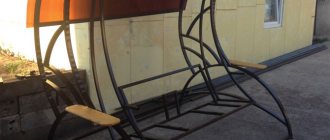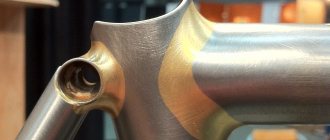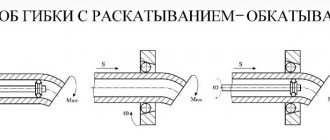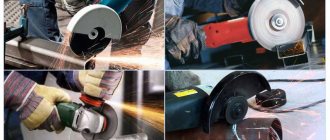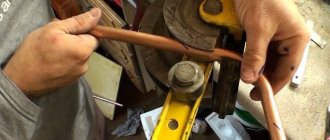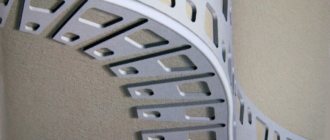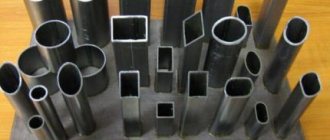MesterulManole
21555 0 3
MesterulManole July 25, 2016Specialization: many years of experience in finishing works of residential and office premises, dachas, country cottages, etc. Hobby: cycling in all its forms
Preheating of the deformable area
Hello dear readers. Today I’ll tell you how to bend a pipe without a pipe bender and with a pipe bender, and how to bend a polypropylene pipe. The topic is of considerable interest since without bent pipes it is difficult to build a greenhouse, gazebo or canopy over the porch.
Selecting a bend method
How to bend a pipe with your own hands? The question is not an easy one. When bending this product yourself, first of all, it is important to take into account the fact that during this process radial and tangential forces arise in the profiled metal, the impact of which can lead to rupture of the section and the appearance of folds on it.
To prevent this from happening, when forming a bend, it is necessary to take into account all the parameters of this process.
The technology that can be applied in each specific case is selected based on:
- Pipe material;
- Its size;
- Required bend angle and radius.
Having made a preliminary assessment of these parameters, you should choose one of the options proposed below. The photos below will help you understand the correct implementation of each of them, demonstrating step by step how to bend a pipe.
Bending a square thin-walled pipe
Very often it is necessary to bend thin-walled square pipes, for example, when creating structures that require smooth rotation. Obviously, bending a strong square pipe by hand will not work. That's why a pipe bender is used. Although, you can use another method.
It is necessary to fill the profile thin-walled pipe with sand. Close the ends with plugs and secure the pipe at the ends in a vice, for example. Next, using light taps with a rubber hammer, bend the pipe until the desired radius is achieved. The sand inside the product will prevent the pipe walls from deforming in an unnecessary direction. And in order to bend the pipe even more, you need to do the same, only as an addition, use a blowtorch for heating. Heated metal bends better.
Heat
When exposed to high temperatures, many metals and their alloys become more ductile and less deformable. This rule applies to aluminum, duralumin, steel, copper, brass products and aluminum-ferrous bronze workpieces.
- When heating pipes made of tin bronze, gray cast iron or zinc alloys, you can get the exact opposite effect - they become more brittle when heated.
- It follows from this that not just any pipe can be heated for bending.
- It is possible to heat galvanized pipes, since their coating is not damaged in this case.
- When heating the product, you should not get too carried away, because under the influence of too high temperatures, oxygen begins to penetrate into the material, which entails its oxidation - an irreversible process that destroys the pipe. As an example, we can consider bending an aluminum billet.
- We heat the bending surface and bring a sheet of paper to it. If it lights up, the product can be bent.
As an indicator of the degree of heating of structures made of steel, their reddening to the state of scale can be used.
Bend a thin-walled metal pipe
You can bend thin-walled metal pipes in any way - even manually with the risk of breaking the product. However, we will only consider correct work without the risk of losing the workpiece. Therefore, you can consider how not only a steel pipe is bent, but also a product made of metal-plastic, aluminum or polypropylene, since they also fall into the list of thin-walled pipes.
The so-called pipe bender has long been used for bending pipes. This is a device that has a specific design. There are several types of pipe benders. And now we will talk about them in detail.
- Manual pipe bender. This is a device that allows you to bend thin-walled pipes of small cross-section. These are mainly pipe products made of non-ferrous metals. For aluminum this is the best tool. You just need to insert the pipe into the tool and use a special lever to gradually bend the pipe. As soon as the desired bending radius is achieved, the resulting product is removed from the pipe bender.
- Hydraulic pipe bender. This device is designed for bending the same thin-walled pipes, but with a larger diameter. In addition, a hydraulic pipe bender can bend pipes with thick walls. There is no need to work manually here, since the efforts are compensated by a hydraulic machine.
- An electromechanical pipe bender is used for bending pipes of any diameter and wall thickness. The device is distinguished by the accuracy of the work and the absence of applied effort on the part of the machine operator.
It is worth noting that in addition to the above devices, there are homemade pipe benders that also allow you to achieve excellent success in your work. For example, a plane-parallel plate. This is a curved piece that has a groove. The pipe is inserted into the clamp, after which it is bent along the plate. This is a rather primitive pipe bender, but effective. Its disadvantage can be considered the constant curvature of the workpiece. Therefore, it is best to have several blanks for different radii of bent pipes. In addition, such a pipe bender can only bend a thin-walled pipe of sufficient length.
Thin-walled pipes made of non-ferrous metals are bent using a metal spring. Since thin metal can burst when bent, a spring is used. It is placed in the pipe to the required bend point. After this you can start working. The spring takes on all the forces and prevents the pipe from breaking at a bend.
Filling with water or sand
Water is poured into the cavity of the workpiece, after which plugs are installed at both ends and cold is placed so that it freezes.
The product is bent by subsequently heating it with a gas burner. This method is not suitable for pipes that have a galvanized coating, as it can lead to damage.
The method using sand is applicable to pipes with a large cross-section or square configuration. Its essence lies in the preliminary filling of the workpiece cavity with sand. Then the pipe is thoroughly heated and bent by tapping it with a mallet. No heat is required to bend galvanized structures.
Bend thin-walled pipes using sand
Pipes that have thin walls and are made of soft and ductile metals can be easily bent using sand. To do this, you need to fill the pipe with sand and close it with plugs on both sides. Then it is necessary to heat the pipe at the bend, for example, with a blowtorch. Once this is done, you can bend the pipe. At the end of the work, pour the sand out of the pipe. In this case, the bulk mixture plays the role of a damper, which takes on all the forces. However, galvanized pipes cannot be bent this way. The fact is that when heated, the galvanized surface will be damaged.
Using Templates
This method is suitable for making complex pipe bends. The simplest template can be a piece of wire, pre-bent in accordance with how the product will be bent.
If it is possible to place the bent pipe section on a plane, self-tapping screws twisted into a piece of plywood can act as a kind of template. Bending is done gradually, checking the resulting result with the template from time to time.
Popular grades of aluminum for bending
The difficulties of bending both pure aluminum and alloys based on it are associated with the following circumstances:
- During the production process, the metal, in most cases, undergoes artificial or natural aging. In general, it is used to stabilize the structure of the original metal, but for aluminum and its alloys the need for such heat treatment also consists in creating a strong film of the main oxide Al2O3 on the surface. Such a film gives the product the necessary corrosion resistance, but, on the other hand, increases strength and, more importantly, reduces ductility.
- Aluminum pipes are produced using several technologies - rolling, hot extrusion and extrusion. The last two methods are becoming increasingly widespread, however, it is after them that the rolled product is significantly strengthened, and its sensitivity to bending stresses increases.
- With any methods of bending profiles, due to the physical characteristics of the process, the location of the so-called “neutral line” is constantly changing - a virtual curve that separates zones with compressive stresses (which are adjacent to the inner surface of the bent workpiece), from zones with tensile stresses located on the outer surface of the bend. Therefore, pipes made of aluminum and its alloys more often crack not along the inner, but along the outer radii.
- Tubular profiles not only made of pure aluminum (for example, grades AD0, AD31, AD33, etc.), but also from duralumin type D1 or D16, as well as from aluminum alloys with manganese, have received wide practical application. All these components reduce the ductility of the original workpieces. Since in everyday life the chemical composition of the initial rolled product is often ignored, failures during bending, in particular along a complex spatial contour, are quite possible.
In this regard, before bending aluminum pipes, it is necessary to accurately determine the grade of the alloy and the conditions for its preliminary heat treatment. If there is no certificate for the product, then such a check can be performed in several ways:
- Study the markings, which are usually given on the end sections of the pipe, and then, using available reference books (at least the same “Handbook of Mechanical Designers” by Anuriev, vol. 1), clarify the necessary ductility indicators;
- Lightly tapping the product with a hammer: as the hardness of the material increases, the sound becomes more sonorous;
- The softer alloy sticks to the file (typical, in particular, for AD0 and AMg6), while the harder alloy peels off from its own base;
- All duralumin (and especially D16) initially have low corrosion resistance, therefore they are often sold with a surface coating using the anodizing method. It is permissible to bend such blanks only at small angles;
- Duralumin pipes do not stain your hands upon contact.
Application of rolls
This method is suitable for bending a metal profile. It is good because its use reduces friction on the surface of the product and reduces the risk of unwanted deformation.
As a result, much less effort has to be applied to obtain the desired bend, and damage to the part is minimized.
Using rolls, you can make your own pipe bender for bending pipes, allowing you to avoid the use of long parts. The three-roller version is most often used. Two rollers located in it play the role of outer supports, and the third one presses into the center of the fold.
This homemade device allows you to process round pipes, rectangular profiles, as well as plates and corners. Using it, you can bend the same radius over a fairly large length of the workpiece.
Bend a polypropylene pipe
Polypropylene pipes have to be bent very often. They are used in water supply and sewerage systems, and even more often in heating. In some cases, it is necessary to bend the pipe so that it is possible to bypass some obstacle, for example, another pipe in the system.
Polypropylene is considered a solid material, however, up to a certain point. Bending a cold pipe will not bring the desired result, but heating the pipe is a different matter. You can use a hair dryer for this. As soon as polypropylene is heated, it becomes soft and flexible. Here you need to bend it to the desired shape. But you can’t overdo it, because polypropylene can completely melt. In addition, work must be carried out carefully, as there is a risk of thermal burns. That's why gloves are used.
Spring
The essence of this option is to place a spring of the required diameter, made of steel, into a bendable workpiece.
When bending, it holds the pipe, preventing it from being deformed incorrectly. The pre-profile element with a spring inserted into it is heated and then bent using pliers.
In certain cases, the spring can be replaced with a wire. Its bundle is installed in the pipe in separate pieces, and after the bend is completed, it is gradually pulled out.
Features of aluminum pipes
Aluminum pipes are distinguished by their low weight, ductility, resistance to corrosion, chemical and temperature influences (able to withstand temperature fluctuations from +150 to -279 degrees).
In addition, these products have high electrical and thermal conductivity, do not contain harmful toxins and can last for a long time. You can make a variety of designs from aluminum tubes with your own hands.
Aluminum pipes are classified according to the following parameters:
- Section shape. They can be round, square, rectangular and shaped.
- Manufacturing method. They are cold-deformed, pressed and welded.
- Length. Measured, unmeasured, having multiple dimensions and coil packaging.
- Chemical composition (grade AI). May be of high or technical purity.
To make the alloy more durable, certain impurities are added to it; however, the degree of its ductility decreases. The plasticity of aluminum products makes them more convenient for machining. Bending an aluminum pipe is very simple and can be done independently. To achieve the integrity and safety of the bent product, it is important to familiarize yourself with the technology of this process in advance.
Profile pipes
Profile pipes can have square, oval and rectangular configurations. It is quite difficult to bend them without violating the technical specifications. The most successful option for carrying out the work would be to use welding with preliminary filing of the walls of the workpiece with a grinder where the bend is planned.
Moreover, it would be advisable to first make cuts and bend the workpiece, and then weld the seams. If the part has a small diameter, then a regular soldering iron will do instead of welding.
Bending using a grinder and a welding machine
There is another way to bend a pipe without a pipe bender, and it is often used when bending metal profile pipes is necessary. To implement this method, you need a grinder and a welding machine. The pipe in the area where it needs to be bent is shallowly sawn transversely in several places on three walls. After this, the product is bent to the required curvature. The fold is made towards the fourth (uncut) wall.
At the end of the bending process, the pre-cut areas are sealed by welding, after which the irregularities and convexities are processed with a file.
Metal-plastic pipes
They bend well by hand without requiring heating. The main thing is to ensure that the workpiece does not become excessively bent.
To perform the bend, you can also use wire by inserting it into the cavity of the metal-plastic pipe being bent, or connect heating to this procedure, while controlling the resulting temperature with a paper sheet.
We bend metal-plastic pipes
Metal-plastic pipes also belong to thin-walled pipes. They are very often used at home. Therefore, they often have to be bent when performing various systems. In some cases, it is necessary to bend pipes up to 180 degrees or more. Very often it is necessary to bend metal-plastic pipes when performing underfloor heating. There are a lot of bends and turns in the pipes.
To avoid damaging the product when bending, it is necessary to use some tools. It will not be possible to immediately bend a thin-walled metal-plastic pipe to a large radius. If you bend the pipe sharply, its inner wall will break. The bending must be carried out smoothly, all the time, moving along the pipe. Five movements and the pipe can be bent at right angles. Next, we gradually continue to bend the product to the desired radius.
It is possible to achieve a distance of parallel sections with a 180 degree bend of up to 15 centimeters. It is noteworthy that in a similar way you can return the shape to the product. It is prohibited to bend metal-plastic pipes using heat for objective reasons.
Photo of how to bend a pipe
Important nuances
It should be noted that any process of changing the original shape of pipes always, to one degree or another, affects their performance and technical characteristics. Therefore, before taking on such work, in the absence of proper experience, it is advisable to experiment on worn out and old pipes that are unsuitable for further use. This will allow you to gain some useful skill and practical ability in this matter in order to avoid mistakes in subsequent work.
Most of the methods described can also be used for bending pipes with special surfaces. For example, methods for bending steel pipes are also suitable when choosing a way to bend a chrome pipe at home. However, it is unlikely that it will be possible to completely avoid damage to the surface layer, so in practice, during manufacturing, the pipe is first bent and then chrome-plated.
Conditions for bending PVC pipes
*
Plastic bends well if it is exposed to certain temperatures. It is important to meet several conditions for bending:
- heating the area to 75 degrees in the place where the bend will be made;
- exposure to the element using vaporous substances.
In order not to buy a lot of unnecessary fittings that require care during installation, craftsmen often use various bending techniques. When working with heated air that will affect plastic, you should be careful: you can not only completely burn the heating area, but also burn your hands. In this case, it is important to carry out manipulations carefully and gradually.
Polypropylene and polyvinyl chloride are easy to bend
It can be difficult to achieve the perfect bend, so before starting work, it is recommended to carefully consider all future turns of the pipeline. It’s worth practicing bending the product in a small segment in advance.
Main stages of work
In this case, we will make a device for making rings with a diameter of 200 mm. To do this, first draw a circle on paper. Then we multiply the required diameter by the number “π” (3.14). We get the value 628 mm.
This is exactly the length you need to cut the workpiece from the metal strip. You can cut off a little more - with a margin.
We bend the strip into a circle and cut off all excess with a grinder. We apply the workpiece to the circle to compare the diameter.
1
Complicated bending of copper pipes
It happens that you need to bend a workpiece of a non-standard profile. For example, not round, but square. The spring method is not applicable here. All that remains is to use sand, a mallet, plugs and two supports. A pipe is placed on the latter, then heated, then the bend is tapped with a hammer until it is given the proper shape.
What to do if you need to bend the tube into a spiral? It's simple - you just need to find a cylindrical template with a diameter equal to the required one. The copper workpiece is slightly heated, then bent. This will create an even spiral.
VIEW Manual pipe bender on AliExpress →
Properties of plastic pipeline
All plastic pipes can be divided according to the material they are made of: they are made from polymers, polyethylene, polyvinyl chloride. The listed materials have good hygienic characteristics, so they are excellently used for arranging a heating network, as well as for organizing water supply in an apartment.
It’s not always possible to bend the material yourself, so you have to use popular methods
To bend a plastic pipe yourself, you need to learn more about its properties:
- Ring stiffness. The high rigidity of PVC allows it to withstand atmospheric pressure of 120 atmospheres.
- Heat resistance. Plastic is resistant to heat, so it is used for arranging water supply systems with hot and cold water, as well as for organizing heating pipelines. When heated, plastic only expands by 5%.
- Low resistance to frost. Due to their low resistance to frost, the materials cannot withstand temperatures below -15 degrees, and therefore require additional thermal insulation.
- High light transmittance. The PVC pipe, painted in various colors, is UV resistant.
PVC products for pipeline installation are available in various diameters.
When heated, a plastic pipe can be carefully bent because it has good elastic properties. Products made from bendable polyvinyl chloride during production can initially be wound into rings - in this form they go on sale.


